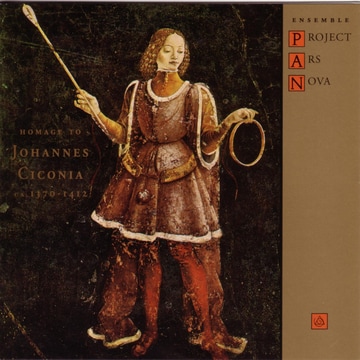|
Homage to Johannes Ciconia (ca. 1370-1412)
madrigals, motets, virelais, ballata and canons: secular music for voices with corno muto, harp, vielle and lute The musicians of Project Ars Nova really know how to perform the music, presenting it in a way that shows they have it in their blood, communicating their sense of excitement in what was and remains some of the most thrilling music written around 1400. --Gramaphome In 1950, Willi Apel published a remarkable collection entitled "French Secular Music of the Late Fourteenth Century", containing music that had previously been virtually unknown, not only to the general public but to most music historians as well. At a time when twentieth century music was undergoing a veritable explosion in both tonal and rhythmic complexity, it came as a stunning surprise for many to find pieces written around 1400 that were rhythmically as wild as anything that was being written in 1950. Taking a prominent place in Apel's collection were works by Matteo de Perugia (d. 1418), a musician of Pope Alexander V; with some fourteen pieces, Matteo was the most widely represented composer in the anthology. Shortly after Apel's publication Heinrich Besseler, one of Germany's most eminent historians, launched a polemic against what he perceived to be a distortion of our perspective of the music at the end of the fourteenth centuy, a distortion caused by our own fascination with 'rhythmic complexity.' In a essay entitled "Hat Matheus de Perusio Epoche gemacht?" he argued that the truly epochal figure was not Matteo da Perugia, but the more obscure Johannes Ciconia. Besseler's argument was twofold: First, although we have a large amount of music by Matteo, it all came from a single manuscript, copied under his aegis, that happened to have survived. Otherwise, Matteo's work appears to have made little impact upon his contemporaries. Indeed, none of his works were copied in the large anthology manuscripts that transmitted most of the surviving repertory from that period. By contrast, Ciconia's music was known during his lifetime, not only in northern Italy but in France, Germany, and as far afield as Poland. Second, in the sound and textures of Ciconia's music, Besseler perceived the shape of much of what was to come in the fifteenth century. Ciconia's music has a simple rhythmic drive with a great deal of forward propulsion, melodic lines of uncommon elegance, a good deal of motivic imitation and repetition, and a clear harmonic language that often yields a radiant sonority of extraordinary beauty. Besseler was right. Beautiful as Matteo's music is, it is Ciconia's art to which the generation of the early fifteenth century composers owes much of their charm and beauty of style. Indeed, in many of the motets of the young Du Fay, one can literally hear his excitement with the kinds of textures and sonorities that he had found in Ciconia. ...Shapely readings, spare in texture but played spiritedly. --New York Times Available here: iTunes Comments are closed.
|
New Albion Records, Inc.Archives
October 2010
|

